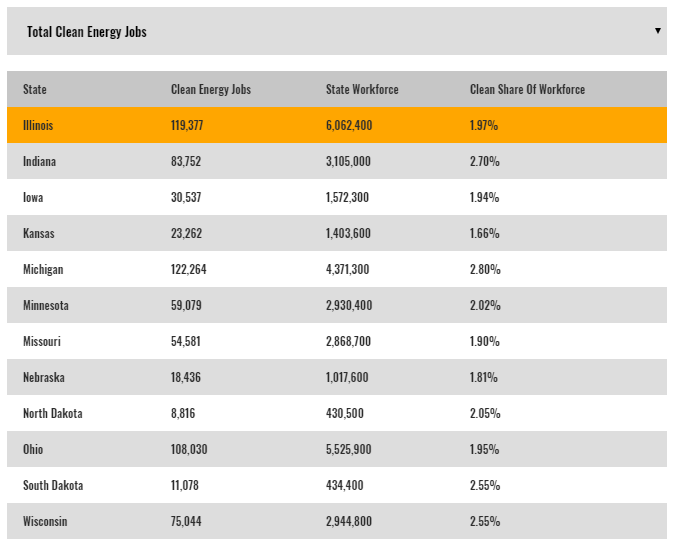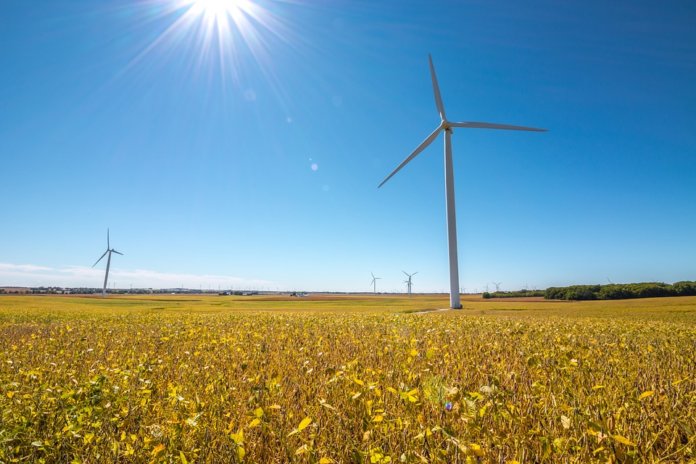More than 714,000 people work in clean energy industries across the Midwest, according to a new analysis of energy jobs data from Clean Energy Trust (CET) and Environmental Entrepreneurs (E2).
The Clean Jobs Midwest report – which cites U.S. Department of Labor statistics as of the end of 2017 – says the region’s clean energy economy employs more than all the waiters and waitresses, computer programmers, lawyers, and Web developers in the Midwest combined.
Energy efficiency leads all clean energy sectors, employing more than a half-million workers (513,695), while renewable energy comes in second with 83,127 jobs – led by solar and wind (73,675). Following these sectors are advanced transportation (79,470), advanced grid (30,104) and clean fuels (7,861).
“I recently graduated from a solar installation training program and am launching a new career in the clean energy industry,” says Julio Ibarra, founder of Positive 617, a southeast Chicago sustainability start-up. “This move was a no-brainer for me: I want to be part of a growing industry that is the home of thousands of good, well-paid jobs.”
Released today, the report highlights the Midwest’s growing importance in America’s transition to renewable energy. It added nearly 4,000 new jobs across renewable industries (5% growth) in a year when total U.S. renewable jobs remained stagnant due to declines in other regions, according to CET and M2. Overall, the Midwest now employs four times more workers in clean energy than fossil fuels.
According to Clean Jobs Midwest, clean energy employment across the 12-state region totaled 714,255 at the end of last year. The region was led by Michigan, Illinois and Ohio, which each had more than 100,000 jobs and ranked in the top 10 nationwide for clean energy jobs. Indiana, Wisconsin and Minnesota also placed in the top 20. Making up the other six states in the analysis are Iowa, Kansas, Missouri, Nebraska, North Dakota and South Dakota.

“The beauty of data is that it cuts through political rhetoric. These findings show that clean energy jobs in wind, solar and energy efficiency are growing across the region and that the Midwest continues to demonstrate it is a fertile region for clean energy innovation, enabling businesses to launch, grow and create jobs,” says Erik G. Birkerts, CEO of CET. “It’s irrational not to embrace and support these sectors that are driving economic development.”
Moving beyond statewide numbers, the most clean jobs in the Midwest come from Cook County, Ill., (54,735); Oakland County, Mich., (30,276); and Hennepin County, Minn. (23,364). The major metro areas of Chicago, Detroit and Minneapolis employ 172,031 jobs, while over 158,531 jobs come from the Midwest’s rural areas, the report says.
Other key findings of the report include as follows:
- More than 30,000 Midwesterners now work in grid modernization and energy storage;
- Construction (39%) and manufacturing (33%) make up the majority of clean energy jobs;
- 80,000 workers are employed across clean vehicle industries;
- Employers project 4.5% clean energy job growth in 2018;
- Small businesses are driving the region’s clean energy sectors, with 71.4% of clean energy businesses employing fewer than 20 individuals; and
- 11.6% of Midwesterners employed in clean energy are veterans.
“Clean jobs count in the Midwest,” remarks Micaela Preskill, E2’s Midwest states advocate. “This report clearly proves the Midwest is not only driving industry job growth but also fast-becoming a key destination for clean energy investment and expansion.”
The report follows E2’s Clean Jobs America analysis, which found that clean energy jobs account for nearly 3.2 million jobs across all 50 states and the District of Columbia. Both reports expand on the 2018 U.S. Energy and Employment Report (USEER) released in May by former Energy Secretary Ernest Moniz’s Energy Futures Initiative and the National Association of State Energy Officials. CET and E2 were partners on the USEER.
More on the report can be found here.




